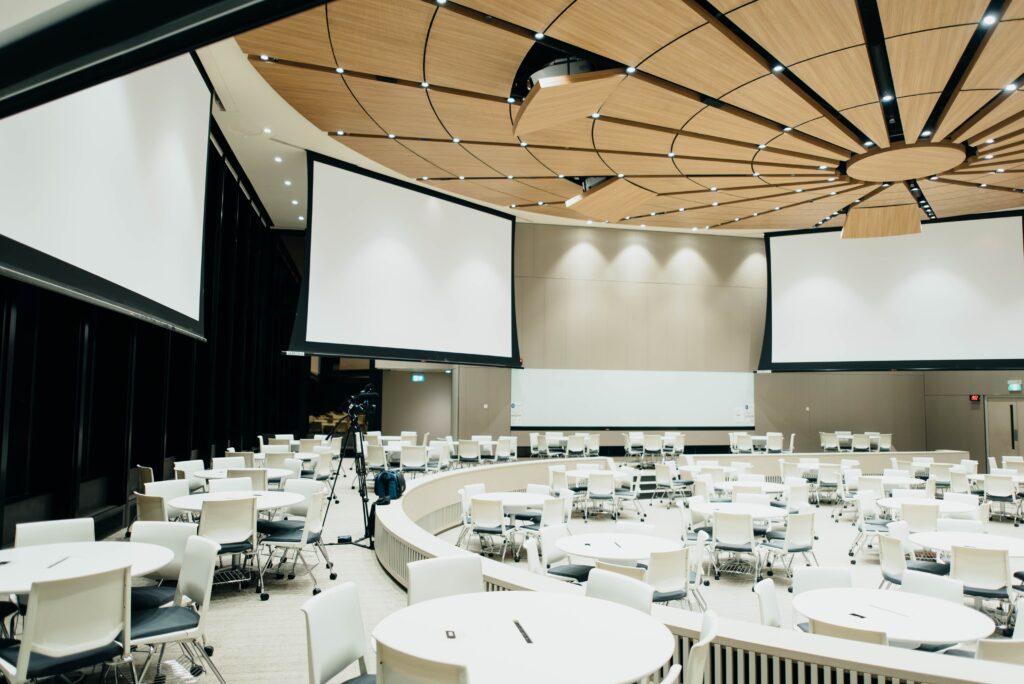The Ultimate Guide to Selecting the Ideal Projector Screen Size

Looking to create a stunning home movie theater? Projector screen size is one of the most crucial elements to consider! While the right size will enhance your viewing experience, the wrong size can be distracting and detract from the overall film-watching and enjoyment. Read this article for the ultimate guide to selecting your new projector screen!
Understanding Aspect Ratios and Screen Format
An important part of choosing your screen, aspect ratios refer to the ratio of width to height of a screen or image. Different aspect ratios are used for different purposes and have various pros and cons.
16:9
The most common aspect ratio is 16:9 or HDTV, which is used for most modern television screens and computer monitors. This format offers a wide field of view, making it ideal for watching movies or playing video games. The downside is that some older films may appear stretched when viewed in this format due to their original aspect ratio being different from 16:9.
4:3 Video
4:3 offers less horizontal viewing space than 16:9 but can be better suited for displaying certain types of content such as text documents or web pages with multiple columns of information.
2.35:1 Cinema Video
Often used in cinemas and on home theater systems, this format possesses a wider field of view compared to other formats like 16:9 or 4:3. The aim is to provide an immersive experience when watching movies, however, this may mean black bars at the top and bottom (if the content isn’t formatted).
When selecting a screen format, there are several factors to consider. Besides aspect ratios, be sure to also think about:
- The screen material (such as canvas)
- The screen size (75” vs. 100”, for example)
- Your viewing distance
- The screen style (such as a fixed frame projection screen or retractable screen)
- Ambient lighting
Home theater and presentations have different requirements for their screen formats, so compare the various aspects of each. Understanding the purpose of the display and aspect ratio so you can compare available screen formats can help ensure that you select the best option for your needs.
Calculating the Optimal Screen Size
To calculate the recommended viewing distance for your home theater or movie projection, you should consider the size of your screen and the resolution of your projector. The larger the screen, the further away you should sit to get optimal image quality.
To determine the optimal viewing distance, one should take into account the field of view of the human eye. According to SMPTE (Society of Motion Picture and Television Engineers) guidelines, it is suggested that viewers sit at a range where the screen fills up a minimum of 30° of their field of vision for standard usage or 40° for a more cinematic experience. To calculate this, simply multiply your screen size by 1.2 for cinematic viewing or 1.6 for standard usage!
Higher-resolution projectors require shorter viewing distances than lower-resolution ones to maintain image quality. Therefore, when calculating viewing distance it’s important to take into account both factors: size and resolution. By doing so, you can ensure that you are sitting at an optimal distance for enjoying movies with excellent image quality.
It is also critical to take into account audience size and seating arrangement. The best practices for your seating arrangement should include ensuring that the screen is visible from all seats in the room. This means that the screen should not be too big or too small for the room. You should also take into account audience size. For example, if there are more people in the audience, then a larger screen may be necessary to ensure everyone can see clearly.
When determining what size screen to use based on room size and audience size, ensure that all viewers have an unobstructed view of the screen. You must also consider how far away viewers will be sitting from the screen and make sure that there is enough space between each seat so that no one’s view is blocked by another person’s head or body.
Besides room and audience size, factors such as ambient light levels should also be taken into account to determine what type of projector or television would work best in your particular space.
Types of Projector Screens
When it comes to choosing a projector or fixed-frame screen, there are many options available. They include:
Fixed Frame Screens
Fixed frame projection screens are screens that are permanently mounted to a wall or ceiling. They typically have an aluminum frame and a tensioned surface, which can be made of vinyl, fabric, or other materials.
Fixed frame projection screens have many advantages, including providing a stable and reliable viewing surface for projecting images. They also tend to look more professional than portable screens. However, the disadvantage is that they cannot be moved around easily and require more installation time and effort than portable screens. It’s also best to have a dedicated media room, because they may not fit in all spaces due to their size and shape.
Motorized Retractable Screens
Motorized retractable TV screens are large flat-screen TVs that can be hidden away when not in use. They are mounted on a wall or ceiling and can be pulled down and out of the way with the press of a button. The benefits of motorized retractable TV screens include:
- Convenience
- Space saving
- Improved aesthetics
However, there are some potential downsides as well, including cost and limited viewing angles (due to their fixed position).
Portable Screens
Portable TV screens are lightweight, collapsible projection screens that can be easily transported and set up for use in a variety of locations. They come in various sizes and shapes, from small tabletop models to large wall-mounted units. Portable projector screens are ideal for any event where a larger viewing area is desired.
Features of portable projector screens include adjustable height and angle settings, as well as the ability to fold up for easy storage and transport. Some models also feature built-in speakers or audio inputs so that sound can be heard clearly without the need for additional equipment.
Factors to Consider When Choosing a Projector Screen Size
When selecting a portable projector screen it is important to consider the size of the room or space where it will be used as well as the type of content being projected onto it. Here are some important considerations:
Screen Height and Width Considerations
The ideal screen height and width for your project can be calculated based on the viewing distance with a projection calculator. This will calculate your ideal aspect ratio and screen size based on the dimensions of your room. You should also consider:
- Desired screen height
- Desired screen width
- Aspect ratio
- Room dimensions
Screen Gain and Brightness
Screen gain should be matched with both your projector and ambient light in the room. A higher gain will increase brightness and contrast, while a lower gain will reduce glare and washout from ambient light. Too high of a gain can cause hot-spotting, so it is key to find a balance between brightness and uniformity. Some projectors may also require specific types of screens for optimal performance, so always read through your desired projector specifications before purchasing.
Screen Material and Viewing Angles
Different screen materials can have a significant impact on viewing angles. For example, matte white screens are the most popular and offer the widest viewing angle, while gray screens can reduce glare from ambient light sources. High-gain screens are designed to increase brightness and contrast in dark rooms, but they also narrow the viewing angle.
When choosing a screen material based on room lighting and seating arrangement, consider how much ambient light there is in the room and where viewers will be seated relative to the screen. If there is a lot of ambient light or if viewers will be seated at wide angles from the screen, then a matte white or gray screen may be best. However if you have minimal ambient light or viewers will primarily be seated directly in front of the screen, then a high-gain screen may provide better image quality.
Business and Educational Presentations
What about those working in a business or education setting? For business presentations, the optimal screen size is typically 16:9 or 16:10 is generally considered the professional standard. In the context of educational presentations, a 6:9 aspect ratio is often used to enhance readability and visibility for text-heavy content. This ratio allows for more lines of text to be displayed on the screen at once, making it easier to follow along with the material.
Practical Tips and Additional Considerations
Be sure to keep in mind user experiences as you make your screen size choices. Generally, a larger room requires a larger projector screen, while a smaller room can accommodate a smaller one. If viewers are sitting closer than 10 feet away from the projection surface, they may need to choose a smaller-sized projector screen so that they don’t strain their eyes trying to see details on an overly large image.
Consider also how many people will be watching at once and their viewing preferences. If there are multiple viewers with different seating arrangements, then it may be beneficial to choose a larger projector screen so that everyone has an optimal viewing experience no matter where they’re seated.
It’s also wise to look up user testimonials and reviews as you make purchases and do future-proofing, especially considering the frequent upgrades and advancements in projection technology that are occurring! Design your space to allow for flexibility for larger screen sizes or any changes in your viewing preferences down the road.
Selecting the Right Projector Screen Size
When picking out your next projector screen, it’s key to consider several elements before committing to a style or size! Consider:
- Room size
- Viewing distance
- Screen format
- Your home size and style
It’s always a smart idea to make use of online resources, like browsing for inspiration and utilizing online calculators to ensure you make the perfect choice. And when in doubt, consider seeking professional advice from the experts at i.e. Smart Systems.
About i.e.Smart Systems
i.e.Smart Systems is a Houston, TX based technology integration partner that specializes in design and installation of audio/visual technology and structured cabling. For more than three decades, our team of in-house experts has partnered with business owners, architectural firms, general contractors, construction managers, real estate developers, and designers in the Houston market, to deliver reliable, scalable solutions that align with their unique goals.




